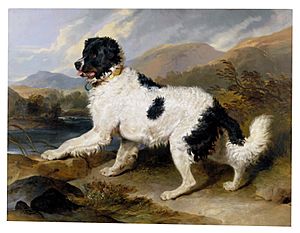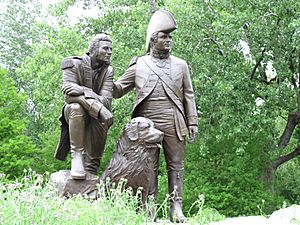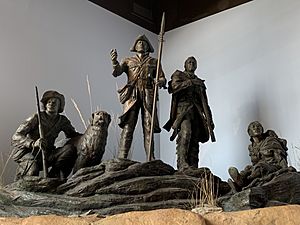Seaman (dog) facts for kids

Statue of Seaman at Fort Mandan, North Dakota
|
|
| Species | Domestic dog |
|---|---|
| Breed | Newfoundland |
| Sex | Male |
| Born | Pittsburgh, Pennsylvania (purchased) |
| Years active | 1803–1806 |
| Known for | Participation in Lewis and Clark Expedition. |
| Owner | Meriwether Lewis |
| Offspring | None known |
| Weight | 150 lb (68 kg) (estimated) |



Seaman, a large Newfoundland dog, was a special member of the Lewis and Clark Expedition. This was the first journey from the Mississippi River to the Pacific coast and back. Seaman was the only animal to complete the entire three-year trip.
Captain Meriwether Lewis bought Seaman in 1803. Lewis was in Pittsburgh, Pennsylvania, waiting for his boats to be ready. He chose a Newfoundland because they are strong and good-natured. Lewis described Seaman as "docile," meaning easy to handle. These dogs are also excellent swimmers and do well on boats. They can even help rescue people from water. Seaman's name shows how good he was in the water. He weighed about 150 pounds (68 kg) and cost $20. This was a lot of money back then, about half a month's pay for an Army captain.
We don't have a clear description of Seaman's exact color or looks. Today, most people imagine him as black or dark brown. These are common colors for Newfoundlands now. However, old paintings from the early 1800s show that many Newfoundlands were white with black or dark spots.
Contents
Seaman's Adventures on the Expedition
Seaman helped the explorers in many ways. Everyone on the trip grew very fond of him. He was truly "our dog."
Seaman was a great hunter. He would catch squirrels in the water and bring them back to the boat. The explorers often ate these squirrels. He also helped retrieve geese and deer. Once, he even caught an antelope swimming across a river.
Native Americans met during the journey were very impressed by Seaman. They had never seen such a large dog before. They were amazed by his intelligence and obedience. Seaman also helped protect the camp. He would "patrol all night" to warn the men about bears. One time, he even chased a buffalo away from their camp while they were sleeping.
One person who studied the expedition said that Captain Lewis seemed happiest when he was exploring alone. He would be with his gun, his notebook, and his dog Seaman.
During the trip, around May 1805, Seaman got hurt. A beaver bit his hind leg, damaging an artery. Captains Meriwether Lewis and William Clark performed surgery on him to fix it. In early 1806, as the group was heading back home, some Native Americans stole Seaman. Lewis quickly sent three men to get him back. The explorers, known as the Corps of Discovery, ate over 200 dogs they bought from Native Americans during their journey. They also ate their horses. But Seaman was always kept safe and was never eaten.
The last time Seaman is mentioned in the expedition journals was on July 15, 1806. Lewis wrote that "the musquetoes continue to infest us in such manner that we can scarcely exist... My dog even howls with the torture he experiences from them." This shows how tough the journey was, even for Seaman.
Seaman After the Journey
Seaman survived the long expedition. Captain Lewis took him home to St. Louis. Sadly, Lewis died early. People say that Seaman refused to leave Lewis's body after he died. When Lewis was buried, Seaman would not leave his grave. He refused to eat any food offered to him. It is said that Seaman became very sad and died of grief right there on his master's grave.
According to a historian from that time, Seaman's collar was in a museum in Alexandria, Virginia, in 1814. The collar had a special message carved into it:
My name is SEAMAN
the dog of captain Meriwether Lewis
whom I accompanied to the Pacifick Ocean
through the interior of the continent of North America
The Name Mix-Up: Seaman or Scannon?
For a while, people thought the dog's name was Scannon. This was because of a mistake when Lewis's journals were copied. However, in 1984, a researcher named Donald Jackson studied the names Lewis and Clark gave to places in Montana. Lewis had named a stream "Seaman’s Creek" (now called Monture Creek). This discovery proved that the dog's true name was "Seaman."
Honoring Seaman
Seaman is remembered today for his part in the famous expedition.
- In 2008, Seaman became the official mascot of Lewis & Clark College's sports teams, the Pioneers.
- He was also suggested to be the State Historical Dog of Missouri, but this idea was not approved.
Many statues and monuments include Seaman:
- A bronze sculpture of Lewis and Seaman, called "Lewis the Naturalist," was displayed at the White House.
- A tablet, like a tombstone, stands in front of the Custom House in Cairo, Illinois.
- Statues can be found at the National Quilt Museum in Paducah, Kentucky, and in front of the Missouri State Capitol in Jefferson City, Missouri.
- You can also see monuments with Seaman in Case Park in Kansas City, Missouri, and at Fort Atkinson State Historical Park in Fort Calhoun, Nebraska.
- A carved wooden statue, "Capt. Lewis and Seaman," is in Gladstone Park, Wausa, Nebraska.
- There are statues at the Lewis and Clark Interpretive Center in Sioux City, Iowa, and a large steel statue of Seaman at Fort Mandan in Washburn, North Dakota.
- Other places with statues of Seaman include Milltown, Montana, Overlook Park in Great Falls, Montana, and Fort Clatsop National Memorial in Seaside, Oregon.
- He is also featured at Cascade Locks Marine Park in Cascade Locks, Oregon, and Columbia View Park in St. Helens, Oregon.
- There's even a Seaman Dog Park at the Sacagawea Interpretative, Cultural, & Educational Center in Salmon, Idaho.
- More monuments and statues that include Seaman are in St. Louis, Missouri, St. Charles, Missouri, Lincoln, Nebraska, and Washougal, Washington.
See also
 In Spanish: Seaman (perro Terranova) para niños
In Spanish: Seaman (perro Terranova) para niños

